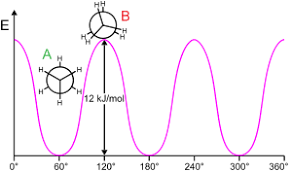Ethane Formula
The ethane formula is

Source:en.wikipedia.org
Ethane Formula
What is Ethane?
Ethane is a colorless, odorless, and flammable gas having two carbon (C) atoms and six hydrogens (H) atoms. It’s only composed of carbon and hydrogen atoms, so it is classified as a hydrocarbon. Ethane has the second-largest percentage in natural gas. As Ethane structure has single bonds it is classified as an alkane.
It has a boiling point of −88.5 °C (−127.3 °F) and the melting point of −182.8 °C (−297.0 °F). Cooling of Ethane under normal pressure forms into a plastic crystal. Further cooling this ethane below between (−183.2 °C; −297.8 °F) changes it to monoclinic metastable ethane II. Ethane can replace oxygen and become an asphyxiation hazard. Ethane also has no acute or chronic toxicological risk.
Chemical Formula of Ethane:
The chemical formula for Ethane is:
It has a molar mass of 30.070 g·mol−1.
Ethane is present in natural gas and is the second larger compound present in it. It can be extracted from natural gas reserves or oil wells. Ethane is present in the atmosphere and seas. The first attempt to synthesize Ethane was done in 1834 by Michael Faraday. He did electrolysis of a potassium acetate solution. Another attempt is made from 1847–1849.
Hermann Kolbe and Edward Frankland tried to produce ethane by reduction of ethyl cyanide and ethyl iodide with potassium metal. Ethane was finally discovered in 1964. Now the commercially available ethane is derived from the distillation of crude petroleum or other natural gas sources. Ethane can easily ignite forming vapors lighter than air. It is not soluble in water but is soluble in ether, ethanol, ether, and benzene.
Ethane may cause asphyxia by the displacement of air because it is heavier than air. Ethane is a very flammable gas and can easily ignite. It is not compatible with oxidizing agents. In the laboratory, we can conveniently synthesize ethane by Kolbe electrolysis.
In this process, electrolysis of an acetate salt occurs. Oxidization of acetate occurs at the anode to produce carbon dioxide and methyl radicals, and the highly reactive methyl radicals combine to produce ethane.
Another example of the electrolysis of acetate salts:
Application of Ethane:
The prime use of ethane is the production of ethene (ethylene) by steam cracking. Ethane is also in use as a refrigerant in cryogenic refrigeration systems. Liquid ethane is also in use in some scientific research, to vitrify water-rich samples for electron microscopy (cryo-electron microscopy).
It acts as a ripening agent for foods, a refrigerant, a substance in producing welding gas and a primary ingredient in mustard gas.
Solved Examples
Q.1.Calculate the Molar mass of Ethane.
Ans- Chemical formula of Ethane is (C2H6):
Mass of Carbon = 12 grams
Mass of Hydrogen = 1 grams
The molar mass of Ethane =
= \((12 \ast 2) + (6 \ast 1)\
= 24 + 6
= 30 grams.
Q.2. What is the combustion of ethane?
Ans- The general reaction of Combustion is
We have to balance the equation. So the actual equation is